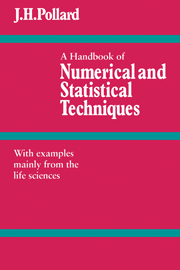Book contents
- Frontmatter
- Contents
- List of statistical and mathematical tables
- Preface
- PART I BASIC NUMERICAL TECHNIQUES
- PART II BASIC STATISTICAL TECHNIQUES
- 8 Probability, statistical distributions and moments
- 9 The normal and related distributions
- 10 The common discrete distributions
- 11 The Pearson system of probability-density functions
- 12 Hypothesis testing
- 13 Point and interval estimation
- 14 Some special statistical techniques
- PART III THE METHOD OF LEAST SQUARES
- Appendix
- References
- Author index
- Subject index
12 - Hypothesis testing
Published online by Cambridge University Press: 18 December 2009
- Frontmatter
- Contents
- List of statistical and mathematical tables
- Preface
- PART I BASIC NUMERICAL TECHNIQUES
- PART II BASIC STATISTICAL TECHNIQUES
- 8 Probability, statistical distributions and moments
- 9 The normal and related distributions
- 10 The common discrete distributions
- 11 The Pearson system of probability-density functions
- 12 Hypothesis testing
- 13 Point and interval estimation
- 14 Some special statistical techniques
- PART III THE METHOD OF LEAST SQUARES
- Appendix
- References
- Author index
- Subject index
Summary
Summary In this chapter we outline the general procedure for testing a statistical hypothesis and summarise a number of standard tests. These tests cover binomial and multinomial hypotheses (sections 12.6–12.8), association in contingency tables (sections 12.9–12.10), goodness-of-fit (sections 12.11–12.12), hypotheses about population means (sections 12.13–12.27), hypotheses about variances (sections 12.28–12.30), hypotheses about correlation (sections 12.31–12.34), and shape of distribution (sections 12.35–12.37).
Introduction
A scientist has recently been given a coin and he wishes to test whether it is unbiased. The obvious experiment for him to carry out is to toss the coin a number of times and observe the number of’ head’ and ‘tail’ outcomes. He decides to toss the coin 1000 times. For an unbiased coin, p = ½, and the expected number of’ heads’ is 500 (section 10.1). If the number of heads turns out to be 511, the scientist will probably conclude that the coin is unbiased (511 is near 500); if on the other hand the number of heads turns out to be 897, he will be rather convinced that the coin is biased, and he will reject any suggestion that it is unbiased.
Both the probability of obtaining exactly 511 heads with an unbiased coin and the probability of obtaining exactly 897 heads with such a coin are small. Why then do we accept the null hypothesis that the coin is unbiased when we obtain 511 heads yet reject it when we obtain 897 heads?
- Type
- Chapter
- Information
- A Handbook of Numerical and Statistical TechniquesWith Examples Mainly from the Life Sciences, pp. 133 - 209Publisher: Cambridge University PressPrint publication year: 1977
- 1
- Cited by



